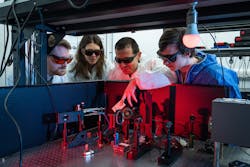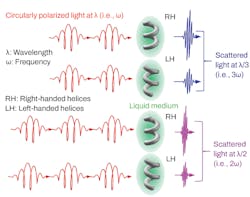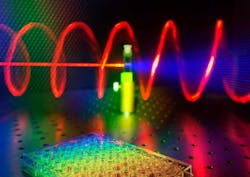‘Impossible theory’ leads to discovery of new photonic effects
Back in 1979, David Andrews, now immediate past president of SPIE, figured out that the way the intensity of light scatters at higher harmonics must depend on the chirality of its scatterers. He realized it would be a new physical effect, wrote about it, and published it in the Journal of Chemical Physics with the appropriate math to support it.1 But for 40 years, no one was able to demonstrate this physical effect.
Laurence Barron, the inventor of Raman optical activity and winner of the 2011 Chirality Medal, also considered it in his 1969 PhD thesis, but didn’t develop it mathematically and publish it.2
Researchers began to suspect the effect might be too weak to observe or some other effect was preventing its observation. Andrews himself began referring to his work as an “Impossible theory.”
Fast forward to 2009, Ventsislav Valev, now a physics professor at the University of Bath in the UK, had the same idea—without any knowledge of David Andrews’ work. He immediately discussed it with his supervisor at the time, Thierry Verbiest at KU Leuven University. “Verbiest told me he and his team had the same idea themselves and even tried it experimentally in the 1990s,” he says.
Unfortunately, they were unable to observe the effect. From that point on, Valev focused on developing very sensitive experimental equipment. “Verbiest and his team used some of the best candidates among organic molecules, so I started searching for a material that could give a stronger signal than any molecule,” he says.
In the mid 2010s, Valev found metal nanohelices being made by Peer Fischer of Max Planck Institute for Intelligent Systems in Stuttgart. These miniscule metal springs are deposited as an ordered array on a silicon wafer.
“We started by having a look at their nonlinear chiroptical properties and found out they’re very strong indeed,” says Valev. “I remember asking Fischer how easy it would be to disperse these nanohelices within a liquid environment. I was expecting an elaborate procedure, possibly involving hydrofluoric acid etching of the helices from the substrates. But Fischer gave the most unexpected answer to my question: very easy! All we had to do was to sonicate the samples within a solution of stabilizing molecules.”
The quest for chiroptical harmonic scattering
Following Fischer’s instructions, in 2019 Valev’s team experimentally demonstrated the chiroptical harmonic scattering effect for silver nanohelices at the second harmonic (see Fig. 1).3 Chirality describes the direction a molecule twists—akin to a right-handed or left-handed curl—and chiral compounds are usually optically active.
“Not only did we observe the effect we were looking for, it was huge!” Valev says.
His team achieved this via an experimental geometry with nanosprings dispersed randomly in water within a glass container, and then aimed a laser at them. The twist—circular polarization—of the laser was switched periodically and light scattered from the container at 90° was analyzed to determine the chirality of the nanosprings.
Valev was still elated when he first presented the results at a conference in Paris. “At the end of my talk, to my great surprise, one of the attendees arose from the back benches of the lecture hall, saying, not without emotion: ‘Ventsi, I think you have shown an effect I predicted 40 years ago.’ It was David Andrews,” he recalls (see Fig. 2).Valev’s team was delighted the experiment was a success—but given how elusive the effect was the last 40 years, Valev feared the newly found effect might only be observable in this one case.
As a next step, the safest bet was to keep the setup as it was, but change the material. “Only after we successfully demonstrated the effect in twisted gold nanocubes as well, did we feel confident trying for the third harmonic,” he adds.4
Going for the third harmonic
Second and third harmonic scattering are entirely different effects—their physical origins are different, so there was no guarantee of success pursuing the third harmonic. “David Andrews wrote his theory only for the second harmonic, so we were in uncharted waters,” says Valev.
For the third harmonic experiments, Valev’s team again used Fischer’s silver nanohelices and it was an immediate success—once again, they recorded a very strong effect.
The results were reported in 2021, but what made the resulting paper special for Valev is that Andrews wrote its theory.5 “Although rare, there are well known stories of experimentalists demonstrating theoretically predicted effects after many decades,” points out Valev. “Much rarer are cases where the theorists and experimentalists then join forces to make further discoveries together. This scientific work has spanned generations, and I am fortunate and humbled to be part of it.”
So far all of the team’s work had involved plasmonic, metal nanoparticles. Naturally, they wondered if whether it might be present in other types of materials.
Earlier this year, Valev’s team, working with Nicholas Kotav’s lab at the University of Michigan, discovered a new photonic effect: chiroptical third-harmonic Mie scattering.6 When circularly polarized light at a wavelength of 1100 nm illuminates cadmium telluride (CdTe) nanohelices, light at the third harmonic streams out on the opposite side from where particles are illuminated (see Fig. 3).Chiroptical harmonic scattering opens up new fields of investigation, where researchers can reveal the nonlinear chiral optical polarizabilities of inorganic nanoparticles and molecules. “This is important at the fundamental level because it helps us to understand the light-matter interaction beyond the first order approximation of linear optics,” says Valev.
As far as applications, the new effect can probe chirality in tiny volumes—typically the focal volume of a lens or a microscope objective (see Fig. 4). Such small volumes are of interest for high-throughput chemistry, where the wells on microplates can hold less than a microliter but also in the case of studying natural products, where the available quantities of chemicals are often very small.Valev’s lab is currently in an exhilarating phase, “where virtually everything we try is new and exciting,” he says. “For instance, we’d like to measure plasmonic-dielectric hybrid nanoparticles, quantum dots, atomic clusters, and many organic molecules.”
To do this, they need to expand their wavelength range and start producing chiroptical harmonic scattering spectra, similar to the current circular dichroism spectra available in most chemistry departments around the world. “Sooner or later, we’ll discover the limits of applicability of our effect, and then it will be time for the technology to mature toward realistic applications,” Valev notes.
In nonlinear optics, “we look at the interactions between light and matter beyond the linear regime,” he adds. “There are terms at the second, third, fourth harmonic, and so on. Within each harmonic, there are electric dipole, quadrupole, and octupole contributions, so there are also magnetic dipoles, etc. All of these terms are usually very small, but with increasingly sensitive detection equipment and decreasing prices of lasers suitable for nonlinear optics, we’re gaining access to them. Consequently, discovery of new effects is bound to happen.”
REFERENCES
1. D. L. Andrews and T. Thirunamachandran, J. Chem. Phys., 70, 1027 (1979).
2. L. D. Barron, The Theory of Optical Birefringence, Lincoln College Oxford (1969).
3. J. T. Collins et al., Phys. Rev. X, 9, 011024 (2019).
4. L. Ohnoutek et al., Nano Lett., 20, 5792–5798 (2020).
5. L. Ohnoutek et al., Laser Photonics Rev., 12, 2100235 (2021).
6. L. Ohnoutek et al., Nat. Photonics, 16, 126–133 (2022).
About the Author
Sally Cole Johnson
Editor in Chief
Sally Cole Johnson, Laser Focus World’s editor in chief, is a science and technology journalist who specializes in physics and semiconductors.




